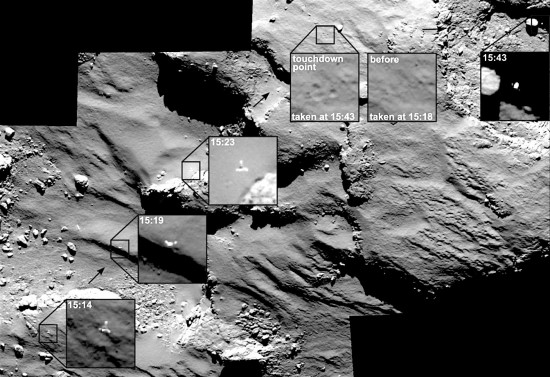
The Philae lander’s bounding path across Comet 67P/Churyumov-Gerasimenko. Credit: ESA/Rosetta/MPS for OSIRIS Team MPS/UPD/LAM/IAA/SSO/INTA/UPM/DASP/IDA
Mar 21, 2016
Cometary electromagnetic fields are influenced by the Sun.
According to a recent press release, the Rosetta Cometary Probe found what appears to be a “magnetic free region” around the nucleus of Comet 67P/Churyumov-Gerasimenko. This observation fits with previous data from the Philae lander, which found that the nucleus, itself, was non-magnetic. The diamagnetic cavity around the comet caused fluctuations in the solar wind strength, as measured by several of Rosetta’s instruments.
Hans-Ulrich Auster, co-principal investigator of the Rosetta Lander Magnetometer and Plasma Monitor (ROMAP) wrote:
“If the surface was magnetised, we would have expected to see a clear increase in the magnetic field readings as we got closer and closer to the surface. But this was not the case at any of the locations we visited, so we conclude that Comet 67P/Churyumov-Gerasimenko is a remarkably non-magnetic object.”
The data is important to those studying the way that planetary systems develop around young stars. Magnetic fields are thought to be necessary for material to be sorted and consolidated in protoplanetary nebulae. Since large quantities of matter need to move around, theory suggests that primordial clouds of gas and dust ought to be “threaded through” with magnetic fields that help bits of ferromagnetic debris “clump together” to form larger and larger clods that eventually condense into planets, moons, asteroids and comets.
Comets are “left overs” from the formation of the Solar System, as consensus theories propose, so their characteristics are supposed to reflect the conditions that existed millions or billions of years ago. Since 67P/Churyumov-Gerasimenko is not magnetized, another addendum to the theory about how planets coalesce from accretion disks is needed.
This is not the first time that a comet was seen to interfere with the solar wind. In October of 2007 Comet McNaught’s charged tail reduced the solar wind velocity and caused a stir among scientists.
Dr. Michael Combi, a University of Michigan space science professor, wrote:
“This was very surprising to me. Way past the orbit of Mars, the solar wind felt the disturbance of this little comet. It will be a serious challenge for us theoreticians and computer modelers to figure out the physics.”
The Solar Wind Ion Composition Experiment (SWICS) onboard the Ulysses spacecraft found that McNaught’s tail had slowed the solar wind to half its normal speed. The solar wind would usually be about 700 kilometers per second at that distance from the Sun, but inside the comet’s ion tail, it was less than 350 kilometers per second.
In an Electric Universe this information is not so surprising. Cometary ion tails always point away from the Sun, because comets are affected by electrical discharges in a weak, radial solar electric field. As they gradually move closer to the Sun, their electric charges become increasingly negative with respect to the solar plasma. Comets lose mass in the form of extremely fine dust and negatively charged ions through a process called cathode sputtering, so their disturbance in the solar plasma is far greater than can be explained by inert objects. The negative charge in the comets and in their tails attracts nearby solar wind protons, decelerating them in the vicinity and causing an overall deceleration of the solar wind.
Since the negative charges on cometary nuclei are discharged by solar wind protons, it is not surprising that low electromagnetic field strength is found there. As written in previous Picture of the Day articles, electrically neutral bodies do not exist in the Universe. Mistaking plasma for hot gas and adhering to traditional gravity-only explanations is what prevents the proper understanding of comets and why they act the way they do. It also explains why the Solar System continues to confound standard theories.
Stephen Smith












